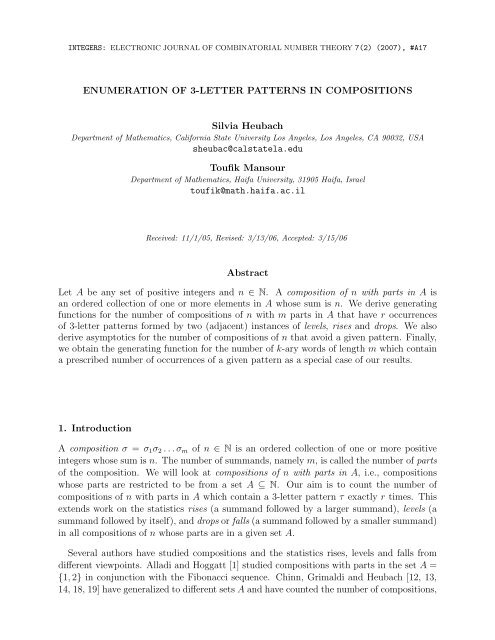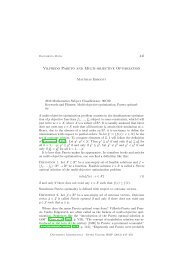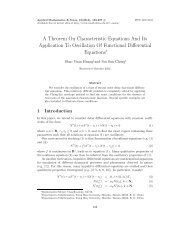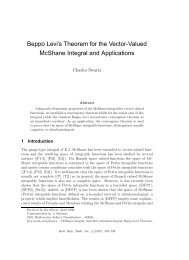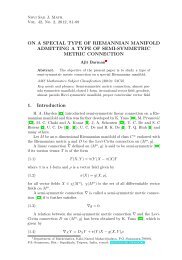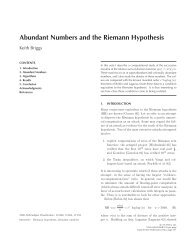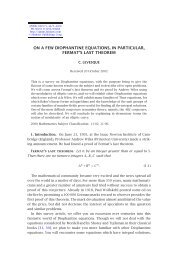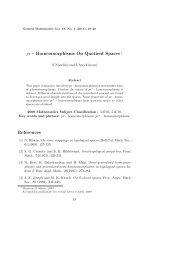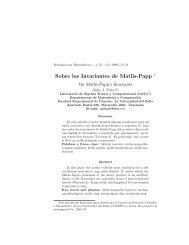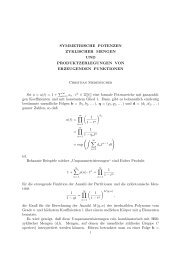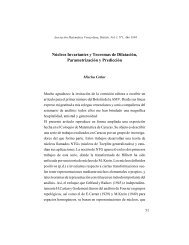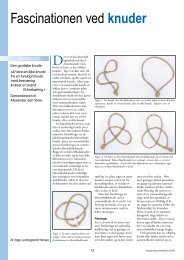ENUMERATION OF 3-LETTER PATTERNS IN COMPOSITIONS ...
ENUMERATION OF 3-LETTER PATTERNS IN COMPOSITIONS ...
ENUMERATION OF 3-LETTER PATTERNS IN COMPOSITIONS ...
Create successful ePaper yourself
Turn your PDF publications into a flip-book with our unique Google optimized e-Paper software.
<strong>IN</strong>TEGERS: ELECTRONIC JOURNAL <strong>OF</strong> COMB<strong>IN</strong>ATORIAL NUMBER THEORY 7(2) (2007), #A17<br />
<strong>ENUMERATION</strong> <strong>OF</strong> 3-<strong>LETTER</strong> <strong>PATTERNS</strong> <strong>IN</strong> <strong>COMPOSITIONS</strong><br />
Silvia Heubach<br />
Department of Mathematics, California State University Los Angeles, Los Angeles, CA 90032, USA<br />
sheubac@calstatela.edu<br />
Toufik Mansour<br />
Department of Mathematics, Haifa University, 31905 Haifa, Israel<br />
toufik@math.haifa.ac.il<br />
Received: 11/1/05, Revised: 3/13/06, Accepted: 3/15/06<br />
Abstract<br />
Let A be any set of positive integers and n ∈ N. A composition of n with parts in A is<br />
an ordered collection of one or more elements in A whose sum is n. We derive generating<br />
functions for the number of compositions of n with m parts in A that have r occurrences<br />
of 3-letter patterns formed by two (adjacent) instances of levels, rises and drops. We also<br />
derive asymptotics for the number of compositions of n that avoid a given pattern. Finally,<br />
we obtain the generating function for the number of k-ary words of length m which contain<br />
a prescribed number of occurrences of a given pattern as a special case of our results.<br />
1. Introduction<br />
A composition σ = σ1σ2 . . . σm of n ∈ N is an ordered collection of one or more positive<br />
integers whose sum is n. The number of summands, namely m, is called the number of parts<br />
of the composition. We will look at compositions of n with parts in A, i.e., compositions<br />
whose parts are restricted to be from a set A ⊆ N. Our aim is to count the number of<br />
compositions of n with parts in A which contain a 3-letter pattern τ exactly r times. This<br />
extends work on the statistics rises (a summand followed by a larger summand), levels (a<br />
summand followed by itself), and drops or falls (a summand followed by a smaller summand)<br />
in all compositions of n whose parts are in a given set A.<br />
Several authors have studied compositions and the statistics rises, levels and falls from<br />
different viewpoints. Alladi and Hoggatt [1] studied compositions with parts in the set A =<br />
{1, 2} in conjunction with the Fibonacci sequence. Chinn, Grimaldi and Heubach [12, 13,<br />
14, 18, 19] have generalized to different sets A and have counted the number of compositions,
2 <strong>IN</strong>TEGERS: ELECTRONIC JOURNAL <strong>OF</strong> COMB<strong>IN</strong>ATORIAL NUMBER THEORY 7(2) (2007), #A17<br />
rises, levels and drops, looking for connections to known sequences (which is only possible<br />
when considering a specific set A).<br />
Carlitz and several co-authors ([6],[8],[9],[10],[11]) studied rises, levels and falls in compositions<br />
on the set [n] = {1, 2, . . . , n} as an extension of the study of these statistics or<br />
patterns in permutations. (Unlike Alladi and Hoggatt, Carlitz et al. included an additional<br />
rise at the beginning and an additional fall at the end of each composition, except in [10].)<br />
These authors extended enumeration questions for permutations to compositions by also<br />
considering the specification of a composition (a list of counts for the occurrences of each<br />
integer) as well as the statistic levels. More recently, Rawlings [25] enumerated compositions<br />
according to weak rises and falls (equality allowed) in connection with restricted words by<br />
adjacencies. He also introduced the notion of ascent variation, (the sum of the increases<br />
of the rises within a composition), which is motivated by a connection to the perimeter of<br />
directed vertically convex polyominoes. Furthermore, Heubach and Mansour [21] developed<br />
a general framework which gives the generating function for the number of rises, levels and<br />
falls for any ordered subset A of N.<br />
“Closest” to permutations are those compositions that do not have levels, which were<br />
called waves by Carlitz and his co-authors. These compositions have also been referred to as<br />
Smirnov sequences (see for example [17]) and Carlitz compositions [23]. One special case of<br />
Carlitz compositions are up-down sequences, in which rises and falls alternate, which were<br />
studied by Carlitz and Scoville [9] and Carlitz [6]. In addition, the problem of enumerating<br />
Carlitz compositions according to rises and falls reduces to the Simon Newcomb problem ([5],<br />
[15]) when the number of falls is disregarded. Another extension of questions first studied<br />
for permutations are the generating functions for the number of compositions according to<br />
specification, rises, falls and maxima by Carlitz and Vaughan [11], and enumeration of pairs of<br />
sequences according to rises, levels and falls [10]. Recently, Gho, Hitczenko, Louchard and<br />
Prodinger have studied distinctness and other characteristics of compositions and Carlitz<br />
compositions using a probabilistic approach [16, 22, 24].<br />
A widely studied topic for permutations is pattern avoidance (see [2] and references therein<br />
for an overview). We follow the motivation of extending enumeration questions from permutations<br />
to compositions by expressing rises, levels and drops as 2-letter patterns. For<br />
example, the pattern 11 corresponds to any occurrence of aiai with ai ∈ A, and thus any<br />
occurrence of the pattern 11 corresponds to the occurrence of a level. Likewise, the pattern<br />
12 corresponds to aiaj with ai < aj, i.e., a rise, and the pattern 21 corresponds to a fall or<br />
drop.<br />
In this paper, we generalize to 3-letter patterns. For example, the pattern 111 corresponds<br />
to any occurrence of aiaiai with ai ∈ A, and therefore corresponds to a level followed by<br />
a level; we will refer to this statistic by the shorthand level+level. Likewise, we can define<br />
patterns for all the combinations of rises, levels and drops. To illustrate this idea, we look<br />
at the composition 1413364. In terms of rises, levels and drops, this composition is represented<br />
by rise+drop+rise+level+rise+drop. It contains the patterns (from left to right) 121<br />
(rise+drop), 312 (drop+rise), 122 (rise+level), 112 (level+rise) and 132 (rise+drop).
<strong>IN</strong>TEGERS: ELECTRONIC JOURNAL <strong>OF</strong> COMB<strong>IN</strong>ATORIAL NUMBER THEORY 7(2) (2007), #A17 3<br />
Statistic Pattern Statistic Pattern<br />
level+level 111 rise+rise 123<br />
level+rise 112 rise+drop=peak 121+132+231<br />
level+drop 221 drop+rise=valley 212+213+312<br />
Table 1. Statistics and their associated patterns<br />
Due to symmetry, each rise is matched by a drop (for each composition that is not symmetric,<br />
there is a composition whose parts are in reverse order, and for symmetric compositions,<br />
the rises and drops are matched within the composition). Thus, the statistic rise+level, 122,<br />
occurs as often as the statistic level+drop, 221. Table 1 lists the statistics to be considered,<br />
and their corresponding patterns. Note that the statistic rise+drop is represented by three<br />
different patterns, which take into account the relative size of the actual summands. For<br />
example, the pattern 121 indicates the occurrence of a1a2a1 where a1 < a2, whereas 132<br />
indicates the occurrence of a1a2a3, where a1 < a3 < a2.<br />
In Section 2 we derive the generating functions for the number of compositions of n, with<br />
m parts in A, which contain a given pattern τ exactly r times, for each of the patterns listed<br />
above. In Section 3 we use tools from complex analysis to derive the exact asymptotics for<br />
the number of compositions of n that avoid a given pattern τ. Finally, in Section 4, we<br />
apply our results to words, i.e., elements of [k] n , where [k] is a (totally ordered) alphabet on<br />
k letters. We obtain previous results in [3, 4], and obtain new results for the patterns peak<br />
and valley. This application shows that compositions form a larger class of combinatorial<br />
objects, containing words as a subclass.<br />
2. Compositions of n with parts in A<br />
Let A = {a1, a2, a3, . . . , ad} or A = {a1, a2, a3, . . .}, where a1 < a2 < . . . . are positive integers.<br />
We will refer to such a set as an ordered subset of N. In the theorems and proofs, we will<br />
treat the two cases together if possible, and will note if the case |A| = ∞ requires additional<br />
steps.<br />
Let Cτ(n, r) (respectively Cτ(j; n, r)) denote the number of compositions of n with parts<br />
in A (respectively with j parts in A) which contain the pattern τ exactly r times. The<br />
corresponding generating functions are given by<br />
Cτ(x, y) = �<br />
Cτ(n, r)x n y r<br />
and<br />
Cτ(x, y, z) = �<br />
n,r,j≥0<br />
n,r≥0<br />
Cτ(j; n, r)x n y r z j = �<br />
Cτ(j; x, y)z j .<br />
j≥0
4 <strong>IN</strong>TEGERS: ELECTRONIC JOURNAL <strong>OF</strong> COMB<strong>IN</strong>ATORIAL NUMBER THEORY 7(2) (2007), #A17<br />
More generally, let Cτ(σ1 . . . σℓ|n, r) (respectively Cτ(σ1 . . . σℓ|j; n, r)) be the number of<br />
compositions of n with parts in A (respectively with j parts in A) which contain τ exactly<br />
r times and whose first ℓ parts are σ1, . . . , σℓ. The corresponding generating functions are<br />
given by<br />
Cτ(σ1 . . . σℓ|x, y) = �<br />
Cτ(σ1 . . . σℓ|n, r)x n y r<br />
and<br />
Cτ(σ1 . . . σℓ|x, y, z) = �<br />
n,r,j≥0<br />
n,r≥0<br />
Cτ(σ1 . . . σℓ|j; n, r)x n y r z j = �<br />
Cτ(σ1 . . . σℓ|j; x, y)z j .<br />
The initial conditions are Cτ(j; x, y) = 0 for j < 0, Cτ(0; x, y) = 1, and Cτ(σ1, . . . σl|j; x, y) =<br />
0 for j ≤ l − 1. In addition,<br />
(1) Cτ(x, y, z) = 1 + �<br />
Cτ(a|x, y, z).<br />
In this section we study the generating functions Cτ(x, y, z) for different patterns τ =<br />
τ1τ2τ3. To find an explicit expression for Cτ(x, y, z), we derive recursive equations using a<br />
variety of strategies for the different patterns. For patterns that contain levels, namely 111,<br />
112, and 221, the recursion is in terms of Cτ(σ1|j; x, y), Cτ(σ1σ2|j; x, y), Cτ(σ1σ2σ3|j; x, y)<br />
and Cτ(x, y, z), which is usually straightforward. However, solving the resulting system of<br />
equations can be difficult, as for example in the case of the pattern 112. We will describe<br />
the derivation of the recursive equations in detail for the pattern 111.<br />
For the pattern 123, we break the composition of n into pieces, some of which have parts<br />
in A, and others that contain only parts larger than the part under consideration. We then<br />
define a second generating function which will play a major role in the recursive equation for<br />
Cτ(x, y, z). In the case of peaks (valleys), we split the composition into parts according to<br />
where the largest (smallest) part occurs, and derive a recursion that will lead to a continued<br />
fraction expansion for the generating function Cτ(x, y, z).<br />
2.1 The pattern 111 (the statistic level+level) In the following theorem we present the<br />
generating function for the number of compositions of n with j parts in A that contain the<br />
pattern 111 exactly r times.<br />
a∈A<br />
Theorem 2.1. Let A be any ordered subset of N. Then<br />
C111(x, y, z) =<br />
1 − �<br />
a∈A<br />
1<br />
j≥0<br />
x a z(1+(1−y)x a z)<br />
1+x a z(1+x a z)(1−y)<br />
Proof. The pattern 111 occurs when a ∈ A occurs three times in a row. Thus, for fixed<br />
a ∈ A and j ≥ 2<br />
C111(a|j; x, y) = C111(aa|j; x, y) +<br />
(2)<br />
�<br />
b∈A,b�=a C111(ab|j; x, y)<br />
= C111(aa|j; x, y) + xaC111(j − 1; x, y) − xaC111(a|j − 1; x, y).<br />
.
<strong>IN</strong>TEGERS: ELECTRONIC JOURNAL <strong>OF</strong> COMB<strong>IN</strong>ATORIAL NUMBER THEORY 7(2) (2007), #A17 5<br />
Note that the factor of xa reflects the fact that we are looking at compositions of n − a. We<br />
now apply a similar argument to C111(aa|j; x, y) to obtain for j ≥ 3<br />
C111(aa|j; x, y) = C111(aaa|j; x, y) +<br />
(3)<br />
�<br />
b∈A,b�=a C111(aab|j; x, y)<br />
= xa � 2a yC111(aa|j − 1; x, y) + x b∈A,b�=a C111(b|j − 2; x, y)<br />
= x a yC111(aa|j − 1; x, y) + x 2a C111(j − 2; x, y) − x 2a C111(a|j − 2; x, y).<br />
Multiplying (2) and (3) by z j , summing over all j ≥ 1, taking into account that the recurrences<br />
hold for j ≥ 2 and j ≥ 3, and solving the resulting system of two equations for<br />
C111(a|x, y, z), we get that<br />
C111(a|x, y, z) = xa z(1 + (1 − y)x a z)<br />
1 + x a z(1 + x a z)(1 − y) C111(x, y, z).<br />
Summing over all a ∈ A and using Eq. (1) for τ = 111, we get the desired result. ✷<br />
Applying Theorem 2.1 to A = N with ai = i for i ≥ 1, we get that the generating function<br />
for the number of compositions of n with parts in N which avoid the pattern 111 is given by<br />
C111(x, 0, 1) =<br />
1<br />
1 − �<br />
i≥1<br />
x i (1+x i )<br />
1+x i (1+x i )<br />
and the values of the corresponding sequence are 1, 1, 2, 3, 7, 13, 24, 46, 89, 170, 324,<br />
618, 1183, 2260, 4318, 8249, 15765, 30123, 57556, 109973, 210137, 401525, 767216, 1465963,<br />
2801115, 5352275 for n = 0, 1, . . . , 25. Note that compositions that avoid the pattern 111<br />
have only isolated levels.<br />
Remark: We note that Carlitz compositions of n, introduced in [7], are those compositions<br />
of n in which no adjacent parts are the same. Thus, Carlitz compositions are precisely those<br />
compositions that avoid levels, or equivalently, avoid the (2-letter) pattern 11. One possible<br />
generalization of Carlitz compositions is to define ℓ-Carlitz compositions of n to be those<br />
compositions of n that avoid ℓ consecutive levels, or in terms of pattern avoidance, avoid the<br />
pattern 11 . . . 11 consisting of ℓ + 1 1’s.<br />
2.2 The patterns 112 and 221 (the statistics level+rise and level+drop) In the<br />
following theorem we present the generating functions for the number of compositions of n<br />
with j parts in A which contain the patterns 112 and 221, respectively, exactly r times.<br />
Theorem 2.2. Let A be any ordered subset of N. Then<br />
and<br />
1<br />
C112(x, y, z) =<br />
1 − � �<br />
d<br />
j=1 xajz �j−1 i=1 (1 − (1 − y)x2aiz 2 �<br />
)<br />
1<br />
C221(x, y, z) =<br />
1 − � �<br />
d<br />
j=1 xajz �d i=j+1 (1 − (1 − y)x2aiz 2 �.<br />
)<br />
,
6 <strong>IN</strong>TEGERS: ELECTRONIC JOURNAL <strong>OF</strong> COMB<strong>IN</strong>ATORIAL NUMBER THEORY 7(2) (2007), #A17<br />
Proof. To derive the generating function C112(x, y, z) we use arguments similar to those in<br />
the proof of Theorem 2.1 to obtain for every a ∈ A<br />
�<br />
C112(b|x, y, x)<br />
(4)<br />
C112(a|x, y, z) = x2a z 2<br />
1 − x 2a z 2 + x2a z 2<br />
1 − x 2a z 2<br />
+ x2a z 2 y<br />
1 − x 2a z 2<br />
�<br />
b∈A,b>a<br />
b∈A,b
<strong>IN</strong>TEGERS: ELECTRONIC JOURNAL <strong>OF</strong> COMB<strong>IN</strong>ATORIAL NUMBER THEORY 7(2) (2007), #A17 7<br />
βj = xa j z<br />
1+x a j z , we get (after algebraic simplification) that<br />
det(Nd)<br />
det(Md) =<br />
1<br />
1 − � �<br />
d<br />
j=1 xajz �j−1 i=1 (1 − (1 − y)x2aiz 2 )<br />
The case |A| = ∞ follows by taking the limit as d → ∞. The proof for C221(x, y, z) follows<br />
with slight modifications. ✷<br />
Setting y = 0 and z = 1 in Theorem 2.2, we get that the generating function for the<br />
number of compositions of n with parts in N that avoid the pattern 112 is given by<br />
1<br />
C112(x, 0, 1) =<br />
1 − �<br />
j≥1 xj �j−1 i=1 (1 − x2i ) ,<br />
and the values of the corresponding sequence are 1, 1, 2, 4, 7, 13, 24, 43, 78, 142, 256, 463,<br />
838, 1513, 2735, 4944, 8931, 16139, 29164, 52693, 95213 for n = 0, 1, . . . , 20. The generating<br />
function for the number of compositions of n with parts in N that avoid the pattern 221 is<br />
given by<br />
C221(x, 0, 1) =<br />
1<br />
1 − � � �<br />
i≥1 xi j≥i+1 (1 − x2j �,<br />
)<br />
and the values of the corresponding sequence are 1, 1, 2, 4, 8, 15, 30, 58, 113, 220, 429, 835,<br />
1627, 3169, 6172, 12023, 23419, 45616, 88853, 173073, 337118 for n = 0, 1, . . . , 20. Note that<br />
there are a lot less compositions of n that avoid 112 than compositions that avoid 221. This<br />
notion can be made more precise using the formulas for the asymptotic behavior given in<br />
Theorem 3.1.<br />
2.3 The pattern 123 (the statistic rise+rise) In the following theorem we will present<br />
the generating function for the number of compositions of n with j parts in A that contain<br />
the pattern 123 exactly r times.<br />
Theorem 2.3. Let A be any ordered subset of N, with |A| = d. Then<br />
C123(x, y, z) =<br />
1 − t1 (A) − d�<br />
where t p (A) = �<br />
1≤i1
8 <strong>IN</strong>TEGERS: ELECTRONIC JOURNAL <strong>OF</strong> COMB<strong>IN</strong>ATORIAL NUMBER THEORY 7(2) (2007), #A17<br />
For any composition σ with parts in A, there are two possibilities: either σ does not<br />
contain a1, in which case the generating function is given by C A1<br />
123(x, y, z), or the composition<br />
contains at least one occurrence of a1, i.e., σ = ¯σa1σk+1 . . . σm, where ¯σ is a composition with<br />
parts from A1, with generating function C A1<br />
123(x, y, z)C A 123(a1|x, y, z). Altogether, we have<br />
(5) C A 123(x, y, z) = C A1<br />
123(x, y, z) + C A1<br />
123(x, y, z)C A 123(a1|x, y, z).<br />
Now let us consider the compositions σ of n with m parts in A starting with a1 which contain<br />
the pattern 123 exactly r times. Again, there are two cases: either σ contains exactly one<br />
occurrence of a1, or the part a1 occurs at least twice in σ. In the first case, the generating<br />
function is given by x a1 z D A1 (x, y, z). If σ contains a1 at least twice, then we split the<br />
composition into pieces according to the second occurrence of a1, i.e., σ = a1¯σa1σk+1 . . . σm,<br />
where ¯σ is a (possibly empty) composition with parts from A1. Splitting off the initial part<br />
a1 results in the generating function x a1 z D A1 (x, y, z) C A 123(a1|x, y, z). Thus,<br />
C A 123(a1|x, y, z) = x a1 zD A1 (x, y, z) + x a1 zD A1 (x, y, z)C A 123(a1|x, y, z).<br />
Solving for C A 123(a1|x, y, z) and substituting into (5) gives<br />
(6) C A 123(x, y, z) =<br />
C A1<br />
123(x, y, z)<br />
1 − x a1zD A1(x, y, z) .<br />
We now derive an expression for D A1 (x, y, z) by considering compositions σ with parts in<br />
A1 such that a1σ contains the pattern 123 exactly r times. If σ does not contain the<br />
part a2, the generating function for σ is given by D A2 (x, y, z). Otherwise, we write σ =<br />
¯σ 1 a2¯σ 2 a2¯σ 3 . . . a2¯σ ℓ+2 with ℓ ≥ 0, where ¯σ j is a (possibly empty) composition with parts<br />
in A2 for j = 1, . . . , ℓ + 2. There are four subcases, depending on whether ¯σ 1 and ¯σ 2 are<br />
empty compositions or not. If ¯σ 1 and ¯σ 2 are both empty compositions, then a1σ = a1a2 or<br />
a1σ = a1a2a2¯σ 3 . . . a2¯σ ℓ+2 , ℓ ≥ 1. In either case we can split off the initial part a2 of σ which<br />
results in one less part, but no reduction in the occurrences of the pattern 123. Thus, the<br />
generating function for σ is given by<br />
x a2<br />
�<br />
z (x a2 A2 ℓ<br />
z D (x, y, z)) =<br />
ℓ≥0<br />
x a2 z<br />
1 − x a2z D A2(x, y, z) .<br />
If ¯σ 1 is the empty composition and ¯σ 2 is not the empty composition, then a1σ = a1a2¯σ 2 or<br />
a1σ = a1a2¯σ 2 a2¯σ 3 . . . a2¯σ ℓ+2 , ℓ ≥ 1, and the generating function for σ is given by<br />
x a2<br />
�<br />
A2 z y(D (x, y, z) − 1) (x a2 A2 ℓ x<br />
zD (x, y, z)) = a2 A2 z y(D (x, y, z) − 1)<br />
1 − xa2zD A2(x,<br />
.<br />
y, z)<br />
ℓ≥0<br />
If ¯σ 1 is not the empty composition and ¯σ 2 is the empty composition, then σ = ¯σ 1 a2 or<br />
σ = ¯σ 1 a2a2¯σ 3 . . . a2¯σ ℓ+2 , ℓ ≥ 1, and the generating function for σ is given by<br />
x a2<br />
�<br />
A2 z(D (x, y, z) − 1) (x a2 A2 ℓ x<br />
zD (x, y, z)) = a2 A2 z(D (x, y, z) − 1)<br />
1 − xa2zD A2(x, y, z) .<br />
ℓ≥0
<strong>IN</strong>TEGERS: ELECTRONIC JOURNAL <strong>OF</strong> COMB<strong>IN</strong>ATORIAL NUMBER THEORY 7(2) (2007), #A17 9<br />
Finally, if both ¯σ 1 and ¯σ 2 are nonempty compositions, then the generating function for σ is<br />
given by<br />
x a2 z(D A2 (x, y, z) − 1) 2<br />
1 − x a2zD A2(x, y, z) .<br />
Adding all four cases, using the shorthand D A for D A (x, y, z), and solving for D A1 we get<br />
(7) D A1 (1 − x<br />
= a2 A2 a2 z(1 − y))D + x z(1 − y)<br />
1 − xa2zD .<br />
A2<br />
We give an explicit expression for DA in the following lemma.<br />
Lemma 2.4. Let A = {a1, . . . , ad} and tp (Ak) = �<br />
k+1≤i1
10 <strong>IN</strong>TEGERS: ELECTRONIC JOURNAL <strong>OF</strong> COMB<strong>IN</strong>ATORIAL NUMBER THEORY 7(2) (2007), #A17<br />
Combining the two double sums by reindexing the second one, adding the terms for p = d<br />
to the first one (which by definition are all zero, as t d+j<br />
d−1 (A1) = 0 for j ≥ 0) and applying (9)<br />
gives<br />
s2 = 1 − t 1 (A) −<br />
Next we rewrite the numerator:<br />
p=2 j=0<br />
d� p−3 � � � p−3 p+j p−2<br />
t (A)(y − 1) .<br />
j<br />
p=3 j=0<br />
s1 = 1 + x a1<br />
d−1 p−2 � � � � 1 p−2 p+j<br />
z(y − 1)t (A1) +<br />
t (A1)(y − 1) j<br />
p−1<br />
+ x a1<br />
d−1 p−2 � � � � p−2 p+j<br />
z<br />
t (A1)(y − 1) j<br />
p + x a1<br />
d−1 p−3 � � � � p−3 p+j<br />
z<br />
t (A1)(y − 1) j<br />
p−1 .<br />
p=2 j=0<br />
p=3 j=0<br />
We now look at the coefficient of (y−1) m and collect terms according to the respective power.<br />
For m = 0, the coefficient is 1. If m = 1, then the coefficient is given by x a1 z t 1 (A1)+t 2 (A1) =<br />
t 2 (A) (using (9)). If m = 2, 3, . . . , d − 1, then the coefficient of (y − 1) m is equal to<br />
m−1 � � � m−1 m+1+j<br />
t (A1) + x j<br />
a1z j=0<br />
j=0<br />
m−2 �<br />
m−1 � � � m−1 m+1+j<br />
= t (A1) + x j<br />
a1z which, using the identity � � � a a<br />
+ b−1 b<br />
j=0<br />
� � m−2 m+j<br />
t (A1) + x j<br />
a1z j=0<br />
�<br />
m−2<br />
�<br />
j=0<br />
� = � a+1<br />
b<br />
j=0<br />
� � m−2 m+j<br />
t (A1) +<br />
j<br />
m−1 � � � m−1 m+1+j<br />
= t (A1) + x j<br />
a1<br />
m−1 � � � m−1 m+j<br />
z t (A1)<br />
j<br />
j=0<br />
m−2 �<br />
j=0<br />
m−1 �<br />
j=1<br />
� � m−2 m+1+j<br />
t (A1)<br />
j<br />
� � m−2 m+j<br />
t (A1)<br />
j−1<br />
� � � � � m−2 m−2<br />
and the fact that = = 0,<br />
−1 m−1<br />
m−1 � � � � m−1 m+1+j<br />
=<br />
t (A1) + x j<br />
a1 m+j<br />
z t (A1) � m−1 � � � m−1 m+j+1<br />
= t (A),<br />
j<br />
where the last equality follows once more from using (9). Thus,<br />
s1 = 1 + t 2 �d−1<br />
m−1 � � � m−1 m+j+1 m<br />
(A)(y − 1) +<br />
t (A)(y − 1) j<br />
m=1 j=0<br />
m=2 j=0<br />
j=0<br />
�d−1<br />
m−1 � � � m−1 m+j+1 m<br />
= 1 +<br />
t (A)(y − 1) .<br />
j<br />
Reindexing the sum and combining this result with the result for s2 completes the proof of<br />
the lemma. ✷<br />
We now can obtain an exact formula for CA 123(x, y, z) as follows. Using (6) and Lemma 2.4<br />
results in<br />
C A C<br />
123(x, y, z) =<br />
A1<br />
123(x, y, z)<br />
1 − xa1z 1+ �d−1 �p−2 p=2 j=0 ( p−2<br />
j )tp+j (A1)(y−1) p−1 .<br />
1−t 1 (A1)− � d−1<br />
p=3<br />
� p−3<br />
j=0 ( p−3<br />
j )t p+j (A1)(y−1) p−2<br />
�
<strong>IN</strong>TEGERS: ELECTRONIC JOURNAL <strong>OF</strong> COMB<strong>IN</strong>ATORIAL NUMBER THEORY 7(2) (2007), #A17 11<br />
Using the same arguments as in the proof of the above lemma we get that<br />
C A 123(x, y, z) = C A1<br />
123(x, y, z) 1 − t1 (A1) − �d−1 �p−3 � � p−3 p+j<br />
p=3 j=0 t (A1)(y − 1) j<br />
p−2<br />
1 − t1 (A) − �d �<br />
tp+j (A)(y − 1) p−2 .<br />
k=0<br />
p=3<br />
� p−3<br />
j=0<br />
Iterating this equation and using that C Ad<br />
123(x, y, z) = C∅ 123(x, y, z) = 1 results in:<br />
C A �d−1<br />
1 − t<br />
123(x, y, z) =<br />
1 (Ak+1) − �d−1 �p−3 � � p−3 p+j<br />
p=3 j=0 t (Ak+1)(y − 1) j<br />
p−2<br />
1 − t1 (Ak) − �d �p−3 �<br />
p=3 j=0 tp+j (Ak)(y − 1) p−2<br />
.<br />
Simplifying and using that t p (Ad) = t p (∅) = 0 gives the desired result. ✷<br />
To apply Theorem 2.3 to A = N, we first show that t p (N) = x (p+1<br />
2 ) z p /(x; x)p, where we<br />
use the customary notation (a; q)n = � n−1<br />
j=0 (1 − a qj ). Clearly, the formula for t p (N) holds<br />
for p = 0. For p ≥ 1, we get from the definition of tp (N) with ai = i for i ≥ 1 that<br />
t p (N) = z p<br />
�<br />
x i1+i2+···+ip p<br />
= z �<br />
x i1+i2+···+ip−1<br />
�<br />
x i<br />
= z p<br />
1≤i1
12 <strong>IN</strong>TEGERS: ELECTRONIC JOURNAL <strong>OF</strong> COMB<strong>IN</strong>ATORIAL NUMBER THEORY 7(2) (2007), #A17<br />
and for s ≥ 1, we define<br />
and<br />
P s (B) = {(i1, . . . , is)| aij ∈ B, j = 1, . . . , s, and i2ℓ−1 < i2ℓ ≤ i2ℓ+1 for 1 ≤ ℓ ≤ ⌊s/2⌋},<br />
Q s (B) = {(i1, . . . , is)| aij ∈ B, j = 1, . . . , s, and i2ℓ−1 ≤ i2ℓ < i2ℓ+1 for 1 ≤ ℓ ≤ ⌊s/2⌋}<br />
M s (B) =<br />
�<br />
(i1,...,is)∈P s (B)<br />
z p<br />
s�<br />
j=1<br />
bij and N s (B) = �<br />
(i1,...,is)∈Q s (B)<br />
On route to the explicit expressions given in Theorem 2.5 we will express the generating<br />
functions for the patterns peak and valley as continued fractions, for which we will use the<br />
1<br />
notation [c0, c1, c2, . . . , cn−1, cn] = c0 +<br />
.<br />
1<br />
c1 +<br />
1<br />
c2 +<br />
...<br />
1<br />
+<br />
cn−1 + 1/cn<br />
Theorem 2.5. Let A = {a1, . . . , ad}, P s (A), Q s (A), M s (A), and N s (A) be defined as above.<br />
Then<br />
C A peak(x, y, z) =<br />
C A valley(x, y, z) =<br />
1 + �<br />
j≥1 M 2j (A)(1 − y) j<br />
1 + �<br />
j≥1 M 2j (A)(1 − y) j − �<br />
j≥0 M 2j+1 (A)(1 − y)<br />
z p<br />
s�<br />
j=1<br />
bij .<br />
j , and<br />
1 + �<br />
j≥1 M 2j (A)(1 − y) j<br />
1 + �<br />
j≥1 M 2j (A)(1 − y) j − �<br />
j≥0 N 2j+1 .<br />
(A)(1 − y) j<br />
Proof. We prove the result for the pattern peak. To derive first a recursion, and then an<br />
explicit formula for CA peak (x, y, z), we concentrate on occurrences of ad, the largest part in<br />
the set A = {a1, a2, . . . , ad}. If ad is surrounded by smaller parts on both sides, then a peak<br />
occurs. Let σ be any composition with parts in A, and define Āk = {a1, . . . , ak} (the index<br />
for the set indicates the largest element included). Note that A = Ād.<br />
We now look at the different possibilities for occurrences of ad. If σ does not contain ad, then<br />
the generating function is given by C Ād−1<br />
peak (x, y, z). If there is at least one occurrence, then<br />
we need to look at three cases for the first occurrence of ad. If the first occurrence is at the<br />
beginning of the composition, i.e., σ = adσ ′ , where σ ′ is a (possibly empty) composition with<br />
parts in A, then no peak occurs, and the generating function is given by xadz CA peak (x, y, z).<br />
If the first (and only) occurrence of ad is at the end of the composition, i.e., σ = ¯σad,<br />
where ¯σ is a non-empty composition with parts in Ād−1, then the generating function is<br />
given by xadz(C Ād−1<br />
peak (x, y, z) − 1). Finally, if the first occurrence of ad is in the interior of<br />
the composition, then σ = ¯σadσ ′ , where σ ′ is a non-empty composition with parts in A.<br />
If σ ′ starts with ad, then σ = ¯σad ad σ ′ , and both ad’s can be split off without decreasing<br />
the number of occurrences of peaks; the generating function is given by (C Ād−1<br />
peak<br />
(x, y, z) −<br />
1)x 2adz 2 C A peak (x, y, z). If σ′ does not start with ad, then a peak occurs and the generating
<strong>IN</strong>TEGERS: ELECTRONIC JOURNAL <strong>OF</strong> COMB<strong>IN</strong>ATORIAL NUMBER THEORY 7(2) (2007), #A17 13<br />
function is given by<br />
(C Ād−1<br />
(x, y, z) − 1<br />
peak )x<br />
� �� �<br />
¯σ non-empty<br />
ad A<br />
z y(Cpeak(x, y, z) − 1<br />
� �� �<br />
σ ′ −x<br />
non-empty<br />
ad A<br />
z Cpeak(x, y, z)<br />
� �� �<br />
does not start with ad<br />
Now, let CA = CA peak (x, y, z). Combining the three cases above, we get<br />
or, equivalently,<br />
(10)<br />
C A = C Ād−1 + x ad z C A + x ad z (C Ād−1 − 1) + x 2ad z 2 C A (C Ād−1 − 1)<br />
+ x ad zy(C A − 1 − x ad zC A )(C Ād−1 − 1),<br />
C A (1 + x<br />
=<br />
adz(1 − y))CĀd−1 − xadz(1 − y)<br />
1 − xadz(1 − xadz)(1 − y) − xadz(xadz(1 − y) + y)C Ād−1<br />
1<br />
=<br />
1 − xadz C<br />
−<br />
Ād−1 − 1<br />
(1 + xadz(1 − y))CĀd−1 − xadz(1 − y)<br />
1<br />
=<br />
1 − xadz 1<br />
−<br />
[xadz(1 − y), 1 − 1/CĀd−1] .<br />
Hence, by induction on d and using the fact that CĀ1 1 = 1−xa1z , we can express the generating<br />
(x, y, z) as a continued fraction.<br />
function C A peak<br />
Lemma 2.6. For A = {a1, . . . , ad}, bi = x ai z, and C A = C A peak (x, y, z),<br />
C A 1<br />
=<br />
.<br />
1<br />
1 − bd −<br />
[bd(1 − y), bd−1, bd−1(1 − y), . . . , b2, b2(1 − y), b1]<br />
Now we derive an explicit formula for C A peak (x, y, z) based on recursions for M s ( Ād) =<br />
M s (A) for odd and even s; if s is odd, both the last and second-to-last elements can equal d,<br />
whereas in the case s even, the second-to-last element can be at most d − 1. By separating<br />
the elements of P s (A) according to whether the last element equals d or is less than d, we<br />
get the following two recursions:<br />
(11)<br />
M 2s+1 (A) = bd M 2s (A) + M 2s+1 ( Ād−1) and<br />
M 2s (A) = bd M 2s−1 ( Ād−1) + M 2s ( Ād−1).<br />
1<br />
Define Gd = [bd(1−y),bd−1,bd−1(1−y),...,b2,b2(1−y),b1] , i.e., Gd consists of the portion of CA in the<br />
continued fraction expansion which has a repeating pattern. We now derive an expression<br />
for Gd in terms of the M s (A).<br />
�<br />
j≥0<br />
Lemma 2.7. For all d ≥ 2, Gd =<br />
M 2j+1 (A)(1 − y) j<br />
1 + �<br />
.<br />
j≥1 M 2j (A)(1 − y) j = G1d G2 d<br />
).
14 <strong>IN</strong>TEGERS: ELECTRONIC JOURNAL <strong>OF</strong> COMB<strong>IN</strong>ATORIAL NUMBER THEORY 7(2) (2007), #A17<br />
Proof. We prove the statement by induction on d. For d = 2, G 1 2 = b1 (only the term j = 0<br />
contributes), G 2 2 = 1 + b1 b2 (1 − y) (only the term j = 1 contributes) and therefore, the<br />
lemma holds. Now let d ≥ 3 and assume that the lemma holds for d − 1, i.e., Gd−1 = G1 d−1<br />
G2 d−1<br />
1<br />
By the definition of Gd it is easy to see that Gd = bd(1−y)+1/(bd−1+Gd−1)<br />
. Substituting the<br />
induction hypothesis for d − 1 into the expression for Gd and simplifying yields<br />
Gd =<br />
bd−1G 2 d−1 + G1 d−1<br />
G 2 d−1 + bd(1 − y)(bd−1G 2 d−1 + G1 d−1 ).<br />
Using the definitions of G1 d−1 and G2 d−1 and (11) yields bd−1G2 d−1 +G1d−1 = G1d , and this result<br />
together with the definitions of G1 d−1 and G2d−1 and (11) yields G2d−1 + bd(1 − y)(bd−1G2 d−1 +<br />
G1 d−1 ) = G2d , which completes the proof of Lemma 2.7. ✷<br />
Now we use Lemma 2.7 and CA 1 = 1−bd−Gd to get (after simplification) that CA equals<br />
1 + �<br />
j≥1 M 2j (A)(1 − y) j<br />
1 − bd − M 1 (A) + �<br />
j≥1 M 2j (A)(1 − y) j − �<br />
j≥1 (bdM 2j (A) + M 2j+1 .<br />
(A))(1 − y) j<br />
Using (11) we get that<br />
C A =<br />
=<br />
1 + �<br />
j≥1 M 2j (A)(1 − y) j<br />
1 − M 1 (A) + �<br />
j≥1 M 2j (A)(1 − y) j − �<br />
j≥1 M 2j+1 (A)(1 − y) j<br />
1 + �<br />
j≥1 M 2j (A)(1 − y) j<br />
1 + �<br />
j≥1 M 2j (A)(1 − y) j − �<br />
j≥0 M 2j+1 (A)(1 − y)<br />
This completes the proof for the pattern peak since the formula also holds for the case<br />
d = ∞. The result for the pattern valley follows with minor modifications, focusing on the<br />
smallest rather than the largest part, replacing Āk with Ak = {ak+1, ak+2, . . . , ad}, and using<br />
the recursions<br />
M s (Ak) = bk+1 N s−1 (Ak+1) + M s (Ak+1) and N s (Ak) = bk+1M s−1 (Ak) + N s (Ak+1),<br />
which are obtained by separating the elements of P s (Ak) according to whether the first<br />
element equals k + 1 or is greater than k + 1. ✷<br />
We now apply Theorem 2.5 to A = N. Similar to the derivation of tp (N), but with extra<br />
care since there are both < and ≤ constraints (resulting in only odd powers of x in the<br />
numerator), we get for all s ≥ 1,<br />
M 2s �<br />
(N) =<br />
x i1+···+i2s 2s s(s+2) 2s<br />
z = x z /(x; x)2s,<br />
M 2s+1 (N) =<br />
N 2s+1 (N) =<br />
1≤i1
<strong>IN</strong>TEGERS: ELECTRONIC JOURNAL <strong>OF</strong> COMB<strong>IN</strong>ATORIAL NUMBER THEORY 7(2) (2007), #A17 15<br />
Substituting these expressions into Theorem 2.5 gives the generating functions for the number<br />
of compositions of n with parts in N without peaks and valleys, respectively, as<br />
and<br />
C N<br />
peak(x, 0, 1) =<br />
C N<br />
valley(x, 0, 1) =<br />
1 + � x<br />
j≥1<br />
j(j+2)<br />
(x;x)2j<br />
1 + � x<br />
j≥1<br />
j(j+2) � x − (x;x)2j j≥0<br />
j2 +3j+1<br />
(x;x)2j+1<br />
1 + � x<br />
j≥1<br />
j(j+2)<br />
(x;x)2j<br />
1 + � x<br />
j≥1<br />
j(j+2) �<br />
− (x;x)2j j≥0<br />
x (j+1)2 .<br />
(x;x)2j+1<br />
Rewriting the generating function as a geometric series allows us to compute the sequence<br />
for the number of peak-avoiding compositions with parts in N. The terms for n = 0 to<br />
n = 20 are given by 1, 1, 2, 4, 7, 13, 22, 38, 64, 107, 177, 293, 481, 789, 1291, 2110, 3445,<br />
5621, 9167, 14947, 24366. The corresponding sequence for valley-avoiding compositions is<br />
given by 1, 1, 2, 4, 8, 15, 28, 52, 96, 177, 326, 600, 1104, 2032, 3740, 6884, 12672, 23327,<br />
42942, 79052, 145528. Note that the first time a peak can occur is for n = 4 (121), and the<br />
first time a valley can occur is for n = 5 (212).<br />
Remark: Even though the statistics peak and valley are in some sense symmetric, one cannot<br />
obtain the number of valley-avoiding compositions from the number of peak-avoiding<br />
compositions. However, there is a connection, namely the number of valleys in the compositions<br />
of n with m parts are equal to the number of peaks in the compositions of<br />
m(n + 1) − n with m parts. This can easily be seen as follows: In each composition of<br />
n with m parts, replace each part σi by (n + 1) − σi, which results in a composition of<br />
m(n + 1) − �m i=1 σi = m(n + 1) − n. This connection will be important in Section ??, when<br />
we apply the results derived for the various patterns to words on k letters.<br />
3. Asymptotics for the number of compositions avoiding τ<br />
We will now use methods from Complex Analysis to compute the asymptotics for the number<br />
of compositions with parts in N which avoid a given pattern τ. We think of the generating<br />
function as a complex function, and indicate this fact by using the variable z instead of the<br />
variable x. Thus, we look at the function Cτ(z) = Cτ(z, 0, 1) = �<br />
n≥0 Cτ(n, 0)zn . Since Cτ(z)<br />
is meromorphic, the asymptotic behavior of Cτ(n, 0) is determined by the dominant pole of<br />
the function Cτ(z) = 1/f(z), i.e., the smallest positive root of f(z) (see for example [26]).<br />
Using Theorem 5.2.1 [26] and the discussions preceding it, we obtain the following result.
16 <strong>IN</strong>TEGERS: ELECTRONIC JOURNAL <strong>OF</strong> COMB<strong>IN</strong>ATORIAL NUMBER THEORY 7(2) (2007), #A17<br />
Theorem 3.1. The asymptotic behavior for τ-avoiding compositions with parts in N is given<br />
by<br />
C111(n, 0) = 0.499301 · 1.91076 n + O((10/7) n )<br />
C112(n, 0) = 0.692005 · 1.80688 n + O((10/7) n )<br />
C221(n, 0) = 0.545362 · 1.94785 n + O((10/7) n )<br />
C123(n, 0) = 0.576096 · 1.94823 n + O((10/7) n )<br />
Cpeak(n, 0) = 1.394560 · 1.62975 n + O((10/7) n )<br />
Cvalley(n, 0) = 0.728207 · 1.84092 n + O((10/7) n ).<br />
Proof. Let ρ be the smallest positive root of f(z). If ρ is a simple pole, then the residue is<br />
given by 1/f ′ (ρ). Since Cτ(n, 0) ≤ 2 n−1 , the number of unrestricted compositions with parts<br />
in N, we know that the radius of convergence of Cτ(z) > 0.5, and therefore, ρ > 0.5 for all<br />
patterns τ. Using Mathematica and Maple, we compute both ρ and 1/f ′ (ρ) for all patterns.<br />
To verify that we are dealing with simple poles in each case, we use the “Principle of the<br />
Argument” (see Theorem 4.10a, [20]), which states that the number of zeros of a function<br />
f(z) is equal to the winding number of the transformed curve f(Γ) around the origin, where<br />
Γ is a simple closed curve. We use as Γ the circle r = |z| = 0.7. Figure 1 shows the six<br />
graphs.<br />
Figure 1. The image of the circle |z| = 0.7 under the respective generating functions.<br />
Clearly, the winding number is 1 in each case, confirming that ρ is a simple pole. Thus, we<br />
obtain from Theorem 5.2.1 [26] that Cτ(n, 0) = K · v n + O((1/r) n ), where K = −1/(ρf ′ (ρ))<br />
and v = 1/ρ, which completes the proof. ✷<br />
Note that Theorem 3.1 for τ = 111 gives the asymptotics for the number of 2-Carlitz<br />
compositions. Asymptotics for the Carlitz compositions were given in [23].
<strong>IN</strong>TEGERS: ELECTRONIC JOURNAL <strong>OF</strong> COMB<strong>IN</strong>ATORIAL NUMBER THEORY 7(2) (2007), #A17 17<br />
4. Counting occurrences of subword patterns<br />
Several authors (for example, see [3, 4] and references therein) have studied the occurrence<br />
of subword patterns in words on k letters. We will apply the results derived in the previous<br />
sections to words on k letters, and thus obtain previous results as special cases.<br />
Let [k] = {1, 2, . . . , k} be a (totally ordered) alphabet on k letters. We call the elements<br />
of [k] n words. A word σ contains a pattern τ if σ contains a subsequence isomorphic to τ.<br />
Otherwise, we say that σ avoids τ. The reversal of τ, denoted by r(τ), is the pattern τ<br />
read from right to left, and the complement of τ, denoted by c(τ), is the pattern obtained<br />
by replacing τi by k + 1 − τi. The set {τ, r(τ), c(τ), c(r(τ))} is called the symmetry class of<br />
τ. It is easy to see that patterns from the same symmetry class occur an equal number of<br />
times in all the words of length m.<br />
The connection between compositions and words is as follows: If C A τ (x, y, z) is the generating<br />
function for the number of compositions of n with m parts in the set A and r occurrences<br />
of the pattern or statistic τ, then C A τ (1, y, z) is the generating function for the number of<br />
words of length m on the alphabet A with r occurrences of the subword or statistic τ. We<br />
are now ready to apply our results from the previous sections to words on k letters.<br />
Theorem 2.1 gives<br />
C [k]<br />
111(1, y, z) =<br />
1<br />
1 − kz(1+(1−y)z)<br />
1+z(1+z)(1−y)<br />
=<br />
1 + z(1 + z)(1 − y)<br />
,<br />
1 − (k − 1 + y)z − (k − 1)(1 − y)z2 i.e., we obtain the results of Example 2.2 [4] and Theorem 3.1 [3].<br />
Theorem 2.2 gives (after simplification)<br />
C [k]<br />
112(1, y, z) = C [k]<br />
221(1, y, z) =<br />
(1 − y)z<br />
(1 − y)z − 1 + (1 − (1 − y)z2 ,<br />
) k<br />
i.e., we obtain Theorem 3.2 [3]. In addition, for y = 0 we obtain the generating function for<br />
the words of length m that avoid the pattern 112, given in Theorem 3.10 [4]:<br />
C [k]<br />
112(1, 0, z) = C [k]<br />
221(1, 0, z) =<br />
z<br />
z − 1 + (1 − z2 .<br />
) k<br />
Note that necessarily C [k]<br />
221(1, y, z) = C [k]<br />
112(1, y, z), as 112 and 221 = c(112) are in the same<br />
symmetry class, which explains why the respective generating functions for compositions are<br />
similar in structure.<br />
Theorem 2.3 for x = 1 yields t p<br />
k ([k]) = � � k p z and thus,<br />
p<br />
C [k]<br />
123(1, y, z) =<br />
1 − k z − � k<br />
p=3<br />
� p−3<br />
j=0<br />
1<br />
� p−3<br />
j<br />
�� k<br />
p+j<br />
� z p+j (y − 1) p−2 .<br />
This generating function for the number of words of length m that contain the pattern 123<br />
exactly r times was given in a different form in Theorem 3.3 of [3]:
18 <strong>IN</strong>TEGERS: ELECTRONIC JOURNAL <strong>OF</strong> COMB<strong>IN</strong>ATORIAL NUMBER THEORY 7(2) (2007), #A17<br />
Theorem 3.3 (Burnstein and Mansour, [3]) F or k ≥ 2,<br />
1<br />
F123(z, y; k) =<br />
1 − k z − �k j=3 (−z)j� � k<br />
(1 − y) ⌊j/2⌋Uj−3(y) j<br />
,<br />
where U0(y) = U1(y) = 1, U2n(y) = (1 − y)U2n−1(y) − U2n−2(y), and U2n+1(y) = U2n(y) −<br />
U2n−1(y). Furthermore, the generating function for Un(y) is given by<br />
�<br />
Un(y)z n =<br />
n≥0<br />
1 + z + z2 1 + (1 + y)z2 .<br />
+ z4 We can prove the equivalence of the two generating functions by substituting x = 1 into<br />
equations (6) and (7) which yields the expressions given in [3] for Fτ(z, y; k) and Dτ(z, y; k).<br />
Comparison of the initial conditions then shows that C [k]<br />
123(1, y, z) = F123(z, y; k).<br />
Substituting y = 0 and x = 1 in Theorem 2.3 we get the generating function for the<br />
number of words of length m avoiding the subword 123:<br />
C [k]<br />
123(1, 0, z) =<br />
1<br />
1 − k z − (−1) p � k<br />
p=3<br />
� p−3<br />
j=0<br />
� �� � p−3 k<br />
zp+j j p+j<br />
.<br />
This can be shown to give the result of Theorem 3.13 [4], namely<br />
(12) F123(z, 0; k) =<br />
1<br />
� k<br />
j=0 aj<br />
� � k<br />
zj j<br />
,<br />
where a3ℓ = 1, a3ℓ+1 = −1 and a3ℓ+2 = 0. We use the form of Theorem 3.3 [3] for y = 0,<br />
which gives<br />
1<br />
F123(z, 0; k) =<br />
1 − k z + �k j=3 (−1)j+1zj� � k<br />
Uj−3(0) j<br />
.<br />
Note that for y = 0 and m ≥ 0, Um(0) = Um−1(0) − Um−2(0), and thus, Um(0) = 1 for m ≡ 0<br />
or 1(mod 6), Um(0) = −1 for m ≡ 3 or 4(mod 6), and Um(0) = 0 otherwise. For j ≥ 3 and<br />
j = 3m, Uj−3(0) = 1 and (−1) j+1 = 1. If j ≥ 3 and j = 3m + 1, then Uj−3(0) and (−1) j+1<br />
will have opposite signs, resulting in a coefficient of −1. Finally, if j ≥ 3 and j = 3m + 2,<br />
then Uj−3(0) = 0. Note that formula (12) also holds for j = 0, 1, 2, and therefore we have<br />
shown the equivalence of the two results.<br />
Now we apply our results to the statistics peak and valley, which will give new results.<br />
Using Theorem 2.5 for A = [k] and x = 1, we need to determine the products M s �<br />
([k]) =<br />
(i1,i2,...,is)∈P s �s ([k]) j=1 bij = zs |P s ([k])|. To determine |P s ([k])| for s = 2ℓ + 1 and s = 2ℓ,<br />
we rewrite the sequence of alternating ≤ and < signs in the definition of P s ([k]) as strict<br />
inequalities and obtain (with jn = in + ⌊(n − 1)/2⌋)<br />
|P 2ℓ+1 � �<br />
k + ℓ<br />
([k])| = |{(j1, j2, . . . , j2ℓ+1)|1 ≤ j1 < j2 < · · · < j2ℓ+1 ≤ k + ℓ}| = .<br />
2ℓ + 1
<strong>IN</strong>TEGERS: ELECTRONIC JOURNAL <strong>OF</strong> COMB<strong>IN</strong>ATORIAL NUMBER THEORY 7(2) (2007), #A17 19<br />
Using the same argument, we obtain |P 2ℓ ([k])| = � � k−1+ℓ<br />
2ℓ 2ℓ . Substituting M ([k]) = z 2ℓ<br />
� � k−1+ℓ<br />
2ℓ<br />
and M 2ℓ+1 ([k]) = z2ℓ+1� � k+ℓ<br />
into Theorem 2.5 gives<br />
2ℓ+1<br />
C [k]<br />
�<br />
j≥0<br />
peak (1, y, z) =<br />
z2j (1 − y) j� � k−1+j<br />
2j<br />
�<br />
j≥0 z2j (1 − y) j� � k−1+j �<br />
− 2j<br />
j≥0 z2j+1 (1 − y) j� �. k+j<br />
2j+1<br />
Since c(peak) = valley, we have C [k]<br />
valley<br />
(1, y, z) = C[k]<br />
peak (1, y, z), and, setting y = 0, the<br />
generating function for the number of words of length m on the alphabet [k] without peaks<br />
(valleys) is given by<br />
�<br />
�<br />
C [k]<br />
peak (1, 0, z) = C[k]<br />
valley (1, 0, z) =<br />
j≥0 z2j� k−1+j<br />
2j<br />
�<br />
j≥0 z2j� � k−1+j �<br />
− 2j<br />
j≥0 z2j+1� k+j<br />
2j+1<br />
Note that once again the symmetry structure of words explains the fact that the generating<br />
functions for the number of compositions that avoid valleys and peaks, respectively, have<br />
similar structure.<br />
Acknowledgments<br />
The authors would like to thank the anonymous referee for his/her careful reading of the<br />
manuscript and for constructive suggestions that have improved this paper, including references<br />
on Carlitz compositions using a probabilistic approach [16, 22, 24].<br />
References<br />
[1] K. Alladi and V. E. Hoggatt, Jr. Compositions with ones and twos. Fibonacci Quart., 13(3):233–239,<br />
1975.<br />
[2] M. Bóna. Combinatorics of permutations. Discrete Mathematics and its Applications (Boca Raton).<br />
Chapman & Hall/CRC, Boca Raton, FL, 2004. With a foreword by Richard Stanley.<br />
[3] A. Burnstein and T. Mansour. Counting occurrences of some subword patterns. Discrete Mathematics<br />
and Theoretical Computer Science, 6(1):1–12, 2003.<br />
[4] A. Burnstein and T. Mansour. Words restricted by 3-letter generalized multipermutation patterns.<br />
Annals of Combinatorics, 7(1):1–14, 2003.<br />
[5] L. Carlitz. Enumeration of sequences by rises and falls: a refinement of the Simon Newcomb problem.<br />
Duke Math. J., 39:267–280, 1972.<br />
[6] L. Carlitz. Enumeration of up-down sequences. Discrete Math., 4:273–286, 1973.<br />
[7] L. Carlitz. Restricted compositions. Fibonacci Quart., 14(3):254–264, 1976.<br />
[8] L. Carlitz. Enumeration of compositions by rises, falls and levels. Math. Nachr., 77:361–371, 1977.<br />
[9] L. Carlitz and R. Scoville. Up-down sequences. Duke Math. J., 39:583–598, 1972.<br />
[10] L. Carlitz, R. Scoville, and T. Vaughan. Enumeration of pairs of sequences by rises, falls and levels.<br />
Manuscripta Math., 19(3):211–243, 1976.<br />
[11] L. Carlitz and T. Vaughan. Enumeration of sequences of given specification according to rises, falls and<br />
maxima. Discrete Math., 8:147–167, 1974.<br />
[12] P. Chinn, R. Grimaldi, and S. Heubach. Rises, levels, drops and “+” signs in compositions: extensions<br />
of a paper by Alladi and Hoggatt. The Fibonacci Quarterly, 41(3):229–239, 2003.<br />
[13] P. Chinn and S. Heubach. (1,k)-compositions. Congressus Numerantium, 164:183–194, 2003.<br />
�.
20 <strong>IN</strong>TEGERS: ELECTRONIC JOURNAL <strong>OF</strong> COMB<strong>IN</strong>ATORIAL NUMBER THEORY 7(2) (2007), #A17<br />
[14] P. Chinn and S. Heubach. Compositions of n with no occurrence of k. Congressus Numerantium, 164:33–<br />
51, 2003.<br />
[15] J. F. Dillon and D. P. Roselle. Simon Newcomb’s problem. SIAM J. Appl. Math., 17:1086–1093, 1969.<br />
[16] W. M. Y. Gho and P. Hitczenko. Average number of distinct part sizes in a random Carlitz composition.<br />
European Journal of Combinatorics, 23(6):647–657, 2002.<br />
[17] I. P. Goulden and D. M. Jackson. Combinatorial enumeration. A Wiley-Interscience Publication. John<br />
Wiley & Sons Inc., New York, 1983. With a foreword by Gian-Carlo Rota, Wiley-Interscience Series in<br />
Discrete Mathematics.<br />
[18] R. P. Grimaldi. Compositions with odd summands. Congressus Numerantium, 142:113–127, 2000.<br />
[19] R. P. Grimaldi. Compositions without the summand 1. Congressus Numerantium, 152:33–43, 2001.<br />
[20] P. Henrici. Applied and Computational Complex Analysis, Vol I. John Wiley & Sons Inc., New York,<br />
1974-1977.<br />
[21] S. Heubach and T. Mansour. Compositions of n with parts in a set. Manuscript, 17 pages, 2003.<br />
[22] P. Hitczenko and G. Louchard. Distinctness of compositions of an integer: A probabilistic analysis.<br />
Random Structures and Algorithms, 19(3-4):407–437, 2001.<br />
[23] A. Knopfmacher and H. Prodinger. On Carlitz compositions. European Journal of Combinatorics,<br />
19(5):579–589, 1998.<br />
[24] G. Louchard and H. Prodinger. Probabilistic analysis of Carlitz compositions. Discrete Mathematics<br />
and Theoretical Computer Science, 5(1):71–96, 2002.<br />
[25] D. Rawlings. Restricted words by adjacencies. Discrete Mathematics, 220:183–200, 2000.<br />
[26] H. S. Wilf. Generatingfunctionology, 2nd Edition. Academic Press, Inc., San Diego, 1994.


